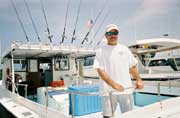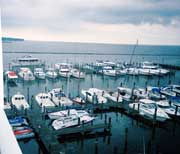
On the Job
How Many Fish Do You Have to Catch to Make a Living?
Captain Randy Dean has found that running a successful charter fishing business is about more than loving to fish.
by Russ Barnes
It’s before six and we amateur fishermen are groggy, having just rolled out of bed. The air is cool. The warm blush of sunrise light reflects off the Bay.
There’s a drowsy bustle along the dock at Rod ’n’ Reel Marina at the mouth of Fishing Creek on Chesapeake Bay. The fishing boats are lined up in their berths just behind the Rod ’n’ Reel and Smokey Joe’s restaurants and adjacent to the new Chesapeake Beach Resort and Spa. Skippers and their mates load their vessels with ice chests and buckets of chum. They duck in and out of the tackle shop, along the dock and above the fish-cleaning table, for last-minute supplies.
Out beyond the several dozen charter fishing boats moored in this 120-slip marina, the channel markers flash red and green, indicating the route out of the harbor and into the Bay. Beyond the markers, gulls dive, early birds already fish. Small Chesapeake surf laps the shore and dock pilings.
Our early morning crew of seven fishermen, including two women, climbs aboard the 42-foot motor vessel Reel Attitude. In the forward cabin, the captain makes a radio check of the latest weather report while his mate for this fishing expedition is busy organizing the tackle.
The most groggy among us awaken when Captain Randy Dean, 43, delivers his safety briefing, reminding us that riding Chesapeake waters is no trivial adventure.
Dean backs Reel Attitude out of her berth, and we slip smoothly by landmarks as the she idles toward the channel markers. Silently the passengers acknowledge in glances to each other that there is something about going out to sea that puts a thrill in your gut.
Just past the markers, Dean opens the throttle and heads for our first fishing location, off Tilghman Island close to Knapps Narrows, which runs through the island and connects the Choptank River with the Bay. “Fish,” Dean says, “usually like this spot.”
As novice fishermen aboard Dean’s boat, we are coddled. Approaching the fishing field, the mate assigns us poles. He describes how to let our line out until its weight hits the bottom of the Bay, about 35 feet down. To lure fish to us, the mate tosses overboard — with a hint of macho flourish — chum, bits and pieces of ground clams and feeder fish. This apparently delicious repast draws large communities of unsuspecting fish to the banquet beneath our boat. This is a seasonal ruse many fishermen apply.
Free-drifting near Tilghman with chum now overboard, we let out our lines, kindly baited by the mate for the sake of the squeamish. Five minutes later, Dean shouts, “Fish on!” Marie-Louise’s pole dips with a tug from the deep. Suddenly, the butt of the rod digs into her belly. Her rod is bent in a semi-circle by the fighting fish. Minutes later, the mate helps her bring the fish over the railing. As the fish comes aboard, it dances wildly on the line and its tail smacks Marie-Louise along the neck.
“Oooh,” she shrieks, ducking sideways from the beast, not wanting to make its acquantance quite yet. The 21-inch rockfish flops onto the deck. The first catch of the day is a nice one.
At the helm, Dean explains how fish think. “The fish like the same places we like,” he says. “If the weather’s good, the fish like it right out in the middle. If the weather’s a bit rough, they like to go alongside an island like Tilghman or Poplar where the water’s smoother.”
Pointing through a cabin window, he asks, “See those birds over there? That means there’s fish around.”
Technology supports the fisherman’s wisdom in his search to satisfy charter parties. Looking at the fathometer above his wheel showing the Bay floor and the fish lying beneath the boat, he says, “These fish are fed. So they’re all stickin’ to the bottom. When they come up to about here, close to the surface, they’re ready to feed.”
The Big Kahuna
Our captain puts me in mind of the word kahuna.
Kahuna is a name given in the Eastern Pacific to powerful priests, doctors, sorcerers and navigators. They’re known for their ability to make things work, bringing advantage all around.
Here, Dean’s proper title is master, and his mastery is certified by the U.S. Coast Guard.
In waters like those of the Chesapeake, a captain’s license allows the skipper to take out a commercial boat with six passengers aboard, called a six pack. A master’s license allows for carrying an unlimited number of passengers up to the limit of the boat. On larger vessels, the master takes responsibility for overall administration of the vessel, while the captain is entrusted mostly to navigation and other sea-going operations.
Aboard Reel Attitude, Dean is the absolute authority. But he tempers his command, when safety permits, with democratic advice and consent.
“Do you think we should chum for rockfish here some more or troll for bluefish from here to Poplar Island?” he asks his mate, who is also a licensed captain.
But when the expedition nears a “close place” — as Mark Twain styles the dangers lurking in all waters — Dean always remains the master of his vessel. Then he bellows “Fish on!” or “Door latch at bottom!” or “Move back!”
 A charter captain is also a businessman. A charter captain is also a businessman.
“Running a charter fishing boat isn’t only about loving to fish and working hard at it,” explains Dean. “That doesn’t guarantee you have a going business. One of the things you have to look at are the business realities, the numbers to get a picture of how you’re doing, what you need to be doing. Another thing is keeping the boat and its engine in shape at a cost you can afford.”
With his mind for making numbers add up, Dean has fashioned a financial model for Chesapeake Bay charter fishing businesses to help skippers to scrutinize how variables affect their bottom line. He’s also treasurer of the Captains’ Association at the Rod ’n’ Reel Marina, which provides services to its 27 charter fishermen and supports good works, including the annual Rod ’n’ Reel Captains Tournament and donations of fish to charitable organizations.
Dean’s an adopted son of the Chesapeake, but he’s a lifelong fisherman.
He grew up in Chamco, West Virginia, he tells us as he reels in a line. Some cagey fish has just eaten the bait around our hook.
Back there in Chamco in the mid-1980s, he traded soda-bottle deposits for fishing tackle and bait at the town’s general store for daily fishing on nearby Meadow River. “I found a way to support my growing fishing addiction,” he says.
Chamco is where Dean learned about that important, and often cantankerous, component of a charter fishing boat: the internal combustion engine. He learned from a top-notch auto mechanic, his father.
“I was the only one in the family willing to hold the flashlight for him when he fixed a car engine at night,” Dean says. “After a while, I realized I was learning a heck of a lot about mechanics just by holding that light and watching how things got fixed.”
We are lucky and do not need to test his mechanical abilities on this trip.
Catch of the Day
At noon, after six hours of morning fishing on the Chesapeake, we return to the Rod ’n’ Reel Harbor with a catch of 16 fish. A small crowd on shore awaits our arrival. Our fish are heaved onto a deck dolly, wheeled to the fish-cleaning table manned by attendants wearing long aprons and wielding sharp scaling knives. In a flash, rockfish, bluefish, croaker and spot are filleted, bagged, packed on ice.
Now there are more tall tales to tell. Captain Randy Dean smiles checking out the crowd “Everybody,” he says, “wants to see the catch of the day.”
Russ Barnes is a writer who works from Bethesda, Maryland. He is currently executive producer of Red Dog Dirt, a film; and author of the Captain Ruh Club, a play that will be performed in Bowie, in October.
Go Fishing
The Chesapeake Country charter fishing season ordinarily runs from mid-April through early December. Be advised that the later the season, the bigger the fish. Among Maryland’s 600-plus licensed captains, about 80 fish out of Anne Arundel County and 90 out of Calvert County. The captains typically organize themselves into associations.
The Maryland Charter Boat Association
Calvert County Charter Fishing Associations
Anne Arundel County Charter Fishing Associations
—Russ Barnes
|
|



 A charter captain is also a businessman.
A charter captain is also a businessman.